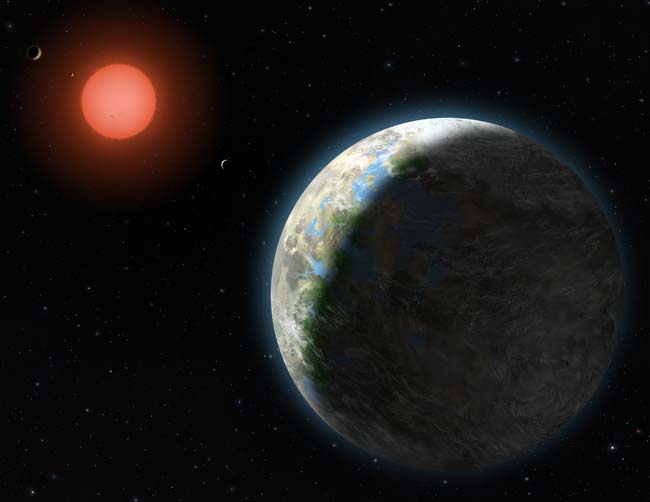Curtain to Lift on Alien Planets by the Hundreds

This story was updated at 1:25 p.m. ET.
Astronomers have detected close to 500 distant alien worlds so far — one of which is the right distance from its star to sustain liquid water and possibly even life — and new advances are yielding more planet discoveries faster than researchers can verify them.
These kind of breakthroughs are now revolutionizing what scientists now know of these distant planets, and could in upcoming decades be capable of finding signs of life.
Astronomers can currently measure the orbit, mass and radius of these exoplanets just by analyzing their faint signals, and they can also detect certain molecules in their atmospheres and even find evidence of wind.
Scientists have discovered a zoo of planets — gas giants known as "hot Jupiters," for instance, that swing closer to their stars than Mercury does our sun, or ancient worlds circling pulsars. Only recently have researchers discovered an exoplanet that is similar to a planet in our own solar system, CoRoT-9b.
Exoplanet overdrive
Although it has taken investigators roughly 15 years to confirm the detection of the nearly 500 planets known so far, the pace promises to pick up rapidly.
NASA's Kepler mission, which uses a spacecraft to survey a large sample of stars, revealed in June that more than 750 possible exoplanets had been detected within the space telescope's first 43 days of operation.
Get the Space.com Newsletter
Breaking space news, the latest updates on rocket launches, skywatching events and more!
"We're undergoing a paradigm shift here — we're finding so many candidates we're not able to validate all of them," planetary scientist Sara Seager at the Massachusetts Institute of Technology told SPACE.com. "Instead of spending so much time studying individual objects because we had so few to look at, now we can move to studying them statistically bunches at a time."
Not only can scientists now identify what types of planets exist, they can see how common each type is, yielding clues into the enigmas of planetary formation. "Perhaps exo-Neptunes are more common than exo-Jupiters," Seager said.
And research into exoplanets is raising new mysteries as well. Planets are known to migrate toward or away from their stars over time, but the process is poorly understood. "Researchers have made models of exoplanet distributions around their stars, and in models of their migration, they don't match the models we observe at all," Seager said.
Habitable or not?
Recently one exoplanet has found itself embroiled in controversy — Gliese 581g, the first world to be discovered in its star's habitable zone, where, as in Earth's case, it is neither too hot nor too cold for liquid water, and possibly for life.
The problem is, a follow-up study failed to confirm that this planet even exists, astronomer Francesco Pepe at the Geneva Observatory in Switzerland found.
Whether Gliese 581g is an actual planet remains an open question.
"His conclusion was simply that their new analysis could not confirm the existence of Gliese 581g, but neither could they rule it out," said astronomer Alan Boss at Carnegie Institution of Washington of Pepe. "It seems to me that the data analysis differences explain most of the differences in the interpretations of these data sets."
One of the planet's discoverers, astronomer Steven Vogt of University of California, Santa Cruz, has said his team is standing by the planetary find.
Current and upcoming techniques
The primary techniques currently used to find exoplanets include:
- The radial velocity method, which looks for changes in a star's velocity toward or away from Earth triggered by a planet's orbit around that star. Those using this method include HARPS at the European Southern Observatory, SOPHIE at Observatoire de Haute-Provence, HIRES at Keck Observatory and a number of observatories in California.
- The transit method, which looks for dips in a star's brightness whenever a planet crosses in front of it. Ground-based observatories that use this include HATnet and WASP, while space-based ones include CoRoT and Kepler.
- The microlensing method, which looks for distortions in light caused by a star's gravitational field.
- The direct imaging of the light from an exoplanet, so far accomplished by the Hubble Space Telescope and the European Southern Observatory's Very Large Telescope.
In the next 15 to 25 years, there are likely to be two generations of space missions to analyze exoplanets in greater detail, said astrobiologist Jean Schneider at the Paris Observatory at Meudon. The first generation will feature large coronagraphs that block out the direct light from a star to help search for giant planets and nearby super-Earths around it, while the second wave will feature equipment to better analyze the light reflected off these exoplanets, revealing what they might look like and what they might have in their atmospheres or on their surfaces.A century from now, telescopes might even become good enough to detect signs of life on exoplanets, Schneider said.Seager was more optimistic."If Earths are common, then the first generation of space telescopes with coronagraphs would get a spectrum and ID signs of life," she said.
Join our Space Forums to keep talking space on the latest missions, night sky and more! And if you have a news tip, correction or comment, let us know at: community@space.com.

Charles Q. Choi is a contributing writer for Space.com and Live Science. He covers all things human origins and astronomy as well as physics, animals and general science topics. Charles has a Master of Arts degree from the University of Missouri-Columbia, School of Journalism and a Bachelor of Arts degree from the University of South Florida. Charles has visited every continent on Earth, drinking rancid yak butter tea in Lhasa, snorkeling with sea lions in the Galapagos and even climbing an iceberg in Antarctica. Visit him at http://www.sciwriter.us









